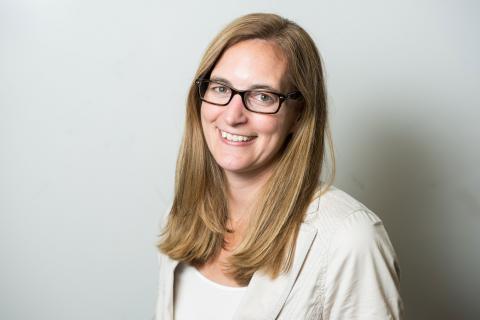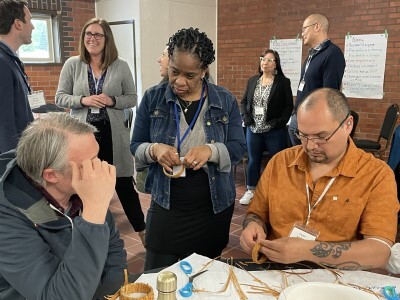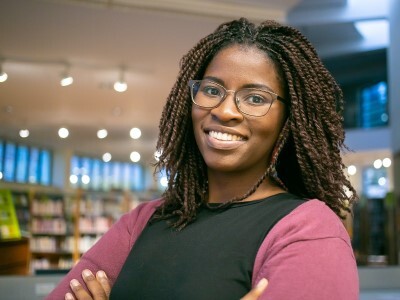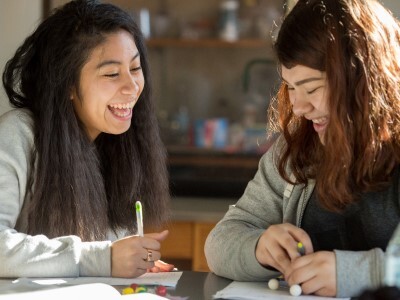How K-12 Can Start Now to Transform the Future
Topics

Next generation learning is all about everyone in the system—from students through teachers to policymakers—taking charge of their own learning, development, and work. That doesn’t happen by forcing change through mandates and compliance. It happens by creating the environment and the equity of opportunity for everyone in the system to do their best possible work.
Challenges of the pandemic are overwhelming, but the need to transform learning is more important than ever. Here's how to get started.
“Now is the time to transform learning.”
“We can’t go back to the way things were.”
“We can’t squander this opportunity to do what we know is right.”
Have you heard statements like these lately? The sentiment they express is like an undercurrent beneath us as K-12 education responds to the challenges posed by this pandemic and accompanying fallout. A response that is all-consuming, tiring everyone, and not working for anyone. Is there room—space, time, energy—for such a big, long-term, future-focused task as transforming learning?
I hope so. A team of district partners, education change experts, and NGLC staff have worked together for the past two years to identify and organize effective change strategies to transform learning. The project’s team represents communities that exemplify enduring districtwide transformation, including Vista Unified, Lindsay Unified, and Arcadia Unified in California; Kettle Moraine in Wisconsin; St. Vrain in Colorado; and Henry County in Georgia.
We pulled together what we learned from these districts about Transformation Design into a framework of core practices along with a set of resources and tools for districts to start, or accelerate and improve, their own journey to transform learning.
But then COVID-19 and Black Lives Matter (BLM) protests disrupted our plans for disruption.
As a team, we decided to share all of this with you now, because it is perhaps more relevant and more valuable now—in the midst of COVID, BLM, the upcoming election, and more—than ever before. As we note on the Transformation Design website:
“The K-12 education system was designed for stability and conformity and can't keep up with our fast-changing world. It was designed for and continues to perpetuate inequity and requires us to actively redesign it for equity. It is our systems, not our people, that need to transform.
The Transformation Design framework identifies six core practices for bringing about enduring, fundamental changes in mindsets, school designs, student learning experiences, and student success outcomes—and to do so inclusively and equitably.”
Is it naïve to think that districts and their communities, so consumed by current events, might explore this new resource? Our district partners say they were better prepared to address COVID's challenges because of their organizational health, developed through the practices described below. But you are in the best position to say when the time is right for your school or district community.
Crisis vs. Transformation
Transformation Design is not a crisis response strategy. Some COVID and BLM issues require a crisis response; if that’s your situation, you won’t really find what you need here. (You might instead look to lessons learned from education responses in New Orleans after Hurricane Katrina and in Puerto Rico after Hurricane Maria. Consult experts in responses to trauma. And check out resources like Always Ready for Learning for a free coaching network, strategy lab, resource bank, and more.)
Transformation Design is a longer-term change strategy that’s focused on culture and systems. It can prevent school districts from adopting a trendy learning strategy as a one-off reform firecracker that fizzles before it has a real chance to dazzle. It can prevent school districts from relying on change management strategies that have started new initiatives but haven’t actually changed the experiences and outcomes that matter most… those that COVID-19 and the BLM movement won’t let us ignore any longer.
From the district partners, our team learned how to achieve a reimagined, equitable version of teaching and learning—where learners are active participants in their learning journey and every learner is celebrated for their gifts and has what they need to succeed. What we learned is that the process to get there must involve active participants at all levels of the system. In particular, it must include those who are traditionally shut out of such efforts. It requires active listening, building trust, encouraging difficult conversations, distributing leadership, and embracing diversity, equity, inclusion, justice, and liberation.
That’s what Transformation Design can help your district do: trust your people and unleash their creativity to imagine a new future; shift your district culture to align with your goals; develop cycles of iteration relying on collaboration over hierarchy and innovation over compliance; accept the messiness and learn from it rather than fight it; commit long-term to changes that take a long time; take small steps aimed at solving challenges everyone agrees need rethinking; and get started by activating students, educators, families, and community partners to drive your transformation.
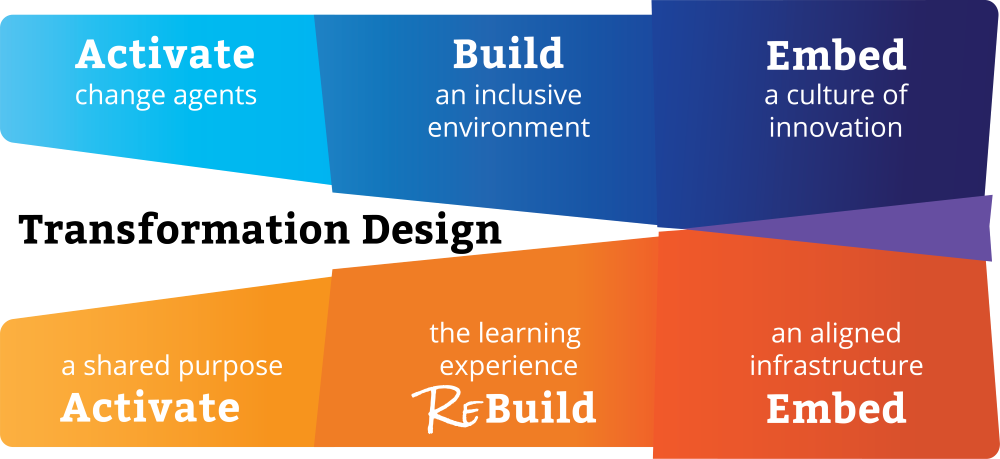
A Framework Grounded in Practice
While change management frameworks are aplenty, they may not be as helpful for district change. For one, we learned that it’s nearly impossible to actually “manage” something as complex and messy as transforming learning. Transformation Design is distinct from business-oriented change management frameworks because it is grounded in educational practice and identifies what successful district communities actually do.
To create the Transformation Design framework, we uncovered the practices used by district communities that have successfully transformed the learning experience in their schools with positive outcomes for their students. The six districts named above are the ones we studied most closely. Then we connected what we learned about these districts’ change practices with the contemporary change practices advocated in the business sector, social movements, public organizations, and education more broadly.
We invited and engaged additional school districts that are also working to transform learning. They joined the project team and helped us refine the Transformation Design framework based on their experience: Rowan-Salisbury Schools in North Carolina; Pequea Valley in Pennsylvania; Oakes Public Schools and Northern Cass School District in North Dakota; and Jeffco Public Schools in Colorado.
All along, we tapped into the expertise of the organizations and scholars in education change who joined the project team to provide greater depth, precision, and context to the districts’ practices.
In Transformation Design, we’ve learned, the people are as important as the tactics; that’s why it matters who is behind Transformation Design. Discover Who We Are.
Transformation for Liberation
Because of this deep grounding in district practice, informed by cutting-edge expertise, we believe district communities that want to transform learning for the equitable achievement of 21st-century outcomes should use the Transformation Design framework.
I want to be clear about the project’s goals as I just stated them: next gen learning, equitable achievement, 21st-century outcomes. As a next phase of our work, the project team is now asking this question:
As a culture and systems change strategy, might Transformation Design also guide districts as they address systemic racism and transform learning for liberatory outcomes?
Maybe. We are particularly hopeful because of the radical inclusion the framework demands. Transformation Design incorporates what we learned from our examination of liberatory design, systemic oppression, the King Philosophy, and other change frameworks addressing power dynamics and social change. However, we will explore whether Transformation Design unintentionally perpetuates dominant White perspectives. And we will continue to identify ways to more intentionally center anti-racism and liberatory learning in Transformation Design.
The project partners commit to revisit the practices, principles, and underlying assumptions of Transformation Design to answer this question. We are entirely open to iteration, revision, and refinement. Can you offer us insights, recommendations, or examples to help us explore the link between anti-racism and Transformation Design? Are you interested in joining the exploration? Please Contact Us and let’s find a way to learn together.
Getting Started during a Crisis
We won’t pretend this is easy. Even before COVID, we knew Transformation Design was a challenge. But if you do decide that it’s important to work toward a different future now, that Transformation Design is relevant and valuable in the current moment, we believe you can get started today. We propose a COVID-19 Entry Point that attempts to balance the urgency of the pressing needs in front of you with the long-view of a districtwide learning transformation.
Explore the COVID-19 Entry Point for more detail, but it goes essentially like this: Engage a small, diverse team of multiple stakeholder representatives to choose a single change—a challenge that your district needs to address, but something that you can approach in a new way (we offer a few ideas). The team agrees to intentionally use Transformation Design practices as it creates solutions for the challenge. Start small—bound the effort to a specific segment of your district. Use your strengths—find one Transformation Design practice that aligns with change strategies that your district already uses but also pushes them to be more inclusive, iterative, and imaginative (we have some suggestions here, too). Then see what happens. Listen and learn. Identify bumps and bruises. Uncover shifts in mindset, behavior, and sense of purpose. Foster any seeds of transformation that emerge and keep moving forward. And please tell us about it so we can learn with you.
We have other tools to help you, including a searchable Resource Hub, district profiles and a literature review, and a strengths-based District Self-Assessment. We will be adding more Entry Points and Deep Dive Guides soon, which you can use to build on your strengths.
Photo at top courtesy of NGLC.

